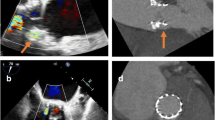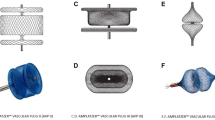Abstract
Paravalvular regurgitation (PVR) is a symptomatic or asymptomatic complication after surgical valve replacement. It may be related to calcification, infection or tissue friability and occurs in 5 % to 17 % of surgical implanted heart valves. Reoperation is associated with a higher morbidity and mortality than the index procedure. Percutaneous closure of PVR can be an effective and lower risk alternative to reoperation. However, feasibility for percutaneous closure has to be assessed by defining the shape, size and location of the defect. Echocardiography with three-dimensional defect reconstruction is a cornerstone for guiding percutaneous PVR closure. Access for aortic PVR is usually retrograde via the femoral artery and access to mitral PVR either retrograde from the aorta, transvenous-transseptal or transapical. Meticulous planning and prudent procedural execution by experienced operators ensuring no impingement of the prosthetic leaflets leads to a high success rate of percutaneous PVR repair.

Similar content being viewed by others
References
Papers of particular interest, published recently, have been highlighted as: • Of importance •• Of major importance
Hammermeister K, Sethi GK, Henderson WG, Grover FL, Oprian C, Rahimtoola SH. Outcomes 15 years after valve replacement with a mechanical versus a bioprosthetic valve: final report of the Veterans Affairs randomized trial. J Am Coll Cardiol. 2000;36:1152–8.
Ionescu A, Fraser AG, Butchart EG. Prevalence and clinical significance of incidental paraprosthetic valvar regurgitation: a prospective study using transoesophageal echocardiography. Heart. 2003;89:1316–21.
Genoni M, Franzen D, Vogt P, Seifert B, Jenni R, Kunzli A, et al. Paravalvular leakage after mitral valve replacement: improved long-term survival with aggressive surgery? Eur J Cardiothorac Surg. 2000;17:14–9.
Ionescu A, Payne N, Fraser AG, Giddings J, Grunkemeier GL, Butchart EG. Incidence of embolism and paravalvar leak after St Jude Silzone valve implantation: experience from the Cardiff Embolic Risk Factor Study. Heart. 2003;89:1055–61.
Koch A, Cesnjevar R, Buheitel G, Singer H. Aortic root abscess complicated by fistulization and intracerebral hemorrhagic infarction. Pediatr Cardiol. 2003;24:576–80.
Miller DL, Morris JJ, Schaff HV, Mullany CJ, Nishimura RA, Orszulak TA. Reoperation for aortic valve periprosthetic leakage: identification of patients at risk and results of operation. J Heart Valve Dis. 1995;4:160–5.
Rallidis LS, Moyssakis IE, Ikonomidis I, Nihoyannopoulos P. Natural history of early aortic paraprosthetic regurgitation: a five-year follow-up. Am Heart J. 1999;138:351–7.
Jindani A, Neville EM, Venn G, Williams BT. Paraprosthetic leak: a complication of cardiac valve replacement. J Cardiovasc Surg (Torino). 1991;32:503–8.
Schoen FJ. The first step to understanding valve failure: an overview of pathology. Eur J Cardiothorac Surg. 1992;6 Suppl 1:S50–3.
Alonso-Lej F. Straight suture plane to avoid periprosthetic leak in aortic valve replacement. Ann Thorac Surg. 1975;19:571–3.
Fischer V. Implantation of artificial heart valve prostheses in the mitral position using continuous sutures–our initial experience. Bratisl Lek Listy. 1991;92:451–3.
Laks H, Pearl JM, Barthel SW, Elami A, Sorensen TJ, Milgalter E. Aortic valve replacement using a continuous suture technique. J Card Surg. 1993;8:459–65.
Safi AM, Kwan T, Afflu E, Al Kamme A, Salciccioli L. Paravalvular regurgitation: a rare complication following valve replacement surgery. Angiology. 2000;51:479–87.
Pate GE, Al Zubaidi A, Chandavimol M, Thompson CR, Munt BI, Webb JG. Percutaneous closure of prosthetic paravalvular leaks: case series and review. Catheter Cardiovasc Interv. 2006;68:528–33.
Echevarria JR, Bernal JM, Rabasa JM, Morales D, Revilla Y, Revuelta JM. Reoperation for bioprosthetic valve dysfunction. A decade of clinical experience. Eur J Cardiothorac Surg. 1991;5:523–6. discussion 7.
Exposito V, Garcia-Camarero T, Bernal JM, Arnaiz E, Sarralde A, Garcia I, et al. Repeat mitral valve replacement: 30-years’ experience. Rev Esp Cardiol. 2009;62:929–32.
de Almeida Brandao CM, Pomerantzeff PM, Souza LR, Tarasoutchi F, Grimberg M, Ramires JA, et al. Multivariate analysis of risk factors for hospital mortality in valvular reoperations for prosthetic valve dysfunction. Eur J Cardiothorac Surg. 2002;22:922–6.
Emery RW, Krogh CC, McAdams S, Emery AM, Holter AR. Long-term follow up of patients undergoing reoperative surgery with aortic or mitral valve replacement using a St. Jude Medical prosthesis. J Heart Valve Dis. 2010;19:473–84.
Hourihan M, Perry SB, Mandell VS, Keane JF, Rome JJ, Bittl JA, et al. Transcatheter umbrella closure of valvular and paravalvular leaks. J Am Coll Cardiol. 1992;20:1371–7.
Hijazi ZM. Transcatheter management of paravalvular mitral leaks: far from ideal. Catheter Cardiovasc Interv. 2004;61:552–3.
Garcia-Borbolla Fernandez R, Sancho Jaldon M, Calle Perez G, Gomez Menchero AE, de Zayas RR, Arana Granado R, et al. Percutaneous treatment of mitral valve periprosthetic leakage. An alternative to high-risk surgery? Rev Esp Cardiol. 2009;62:438–41.
Kort HW, Sharkey AM, Balzer DT. Novel use of the Amplatzer duct occluder to close perivalvar leak involving a prosthetic mitral valve. Catheter Cardiovasc Interv. 2004;61:548–51.
Piechaud JF. Percutaneous closure of mitral paravalvular leak. J Interv Cardiol. 2003;16:153–5.
Pate GE, Thompson CR, Munt BI, Webb JG. Techniques for percutaneous closure of prosthetic paravalvular leaks. Catheter Cardiovasc Interv. 2006;67:158–66.
••Ruiz CE, Jelnin V, Kronzon I, Dudiy Y, Del Valle-Fernandez R, Einhorn BN, et al. Clinical outcomes in patients undergoing percutaneous closure of periprosthetic paravalvular leaks. J Am Coll Cardiol. 2011;58:2210–7. A large series with 43 patients including long-term follow-up and a review of the literature.
•• Sorajja P, Cabalka AK, Hagler DJ, Rihal CS. Percutaneous repair of paravalvular prosthetic regurgitation: acute and 30-day outcomes in 115 patients. Circ Cardiovasc Interv. 2011;4:314–21. This is the largest published series of percutaneous PVR closure involving 155 patients.
Chen YT, Kan MN, Chen JS, Lin WW, Chang MK, Hu WS, et al. Detection of prosthetic mitral valve leak: a comparative study using transesophageal echocardiography, transthoracic echocardiography, and auscultation. J Clin Ultrasound. 1990;18:557–61.
Zoghbi WA, Chambers JB, Dumesnil JG, Foster E, Gottdiener JS, Grayburn PA, et al. Recommendations for evaluation of prosthetic valves with echocardiography and doppler ultrasound: a report From the American Society of Echocardiography’s Guidelines and Standards Committee and the Task Force on Prosthetic Valves, developed in conjunction with the American College of Cardiology Cardiovascular Imaging Committee, Cardiac Imaging Committee of the American Heart Association, the European Association of Echocardiography, a registered branch of the European Society of Cardiology, the Japanese Society of Echocardiography and the Canadian Society of Echocardiography, endorsed by the American College of Cardiology Foundation, American Heart Association, European Association of Echocardiography, a registered branch of the European Society of Cardiology, the Japanese Society of Echocardiography, and Canadian Society of Echocardiography. J Am Soc Echocardiogr. 2009;22:975–1014. quiz 82–4.
De Cicco G, Russo C, Moreo A, Beghi C, Fucci C, Gerometta P, et al. Mitral valve periprosthetic leakage: anatomical observations in 135 patients from a multicentre study. Eur J Cardiothorac Surg. 2006;30:887–91.
De Cicco G, Lorusso R, Colli A, Nicolini F, Fragnito C, Grimaldi T, et al. Aortic valve periprosthetic leakage: anatomic observations and surgical results. Ann Thorac Surg. 2005;79:1480–5.
Deftereos S, Giannopoulos G, Raisakis K, Kaoukis A, Kossyvakis C. Intracardiac echocardiography imaging of periprosthetic valvular regurgitation. Eur J Echocardiogr. 2010 Jun;11(5):E20. doi: 10.1093/ejechocard/jep227.
•• Rihal CS, Sorajja P, Booker JD, Hagler DJ, Cabalka AK. Principles of percutaneous paravalvular leak closure. JACC Cardiovasc Interv. 2012;5:121–30. Review on the technical principles of percutaneous PVR repair.
• Nietlispach F, Johnson M, Moss RR, Wijesinghe N, Gurvitch R, Tay EL, et al. Transcatheter closure of paravalvular defects using a purpose-specific occluder. JACC Cardiovasc Interv. 2010;3:759–65. This article covers the first-in-human experience with the Amplatzer Vascular Plug III.
Martinez CA, Rosen R, Cohen H, Ruiz CE. A novel method for closing the percutaneous transapical access tract using coils and gelatin matrix. J Invasive Cardiol. 2010;22:E107–9.
Nietlispach F, Eckstein F, Seeberger M, Osswald S, Kaufmann BA, Reuthebuch O. Closure of apical access site after transapical, transcatheter paravalvular leak closure. Can J Cardiol. 2012;28:516. e5–7.
Barbash IM, Saikus CE, Ratnayaka K, Faranesh AZ, Kocaturk O, Wu V, et al. Limitations of closing percutaneous transthoracic ventricular access ports using a commercial collagen vascular closure device. Catheter Cardiovasc Interv. 2011;77:1079–85.
Sugeng L, Shernan SK, Salgo IS, Weinert L, Shook D, Raman J, et al. Live 3-dimensional transesophageal echocardiography initial experience using the fully-sampled matrix array probe. J Am Coll Cardiol. 2008;52:446–9.
Cortes M, Garcia E, Garcia-Fernandez MA, Gomez JJ, Perez-David E, Fernandez-Aviles F. Usefulness of transesophageal echocardiography in percutaneous transcatheter repairs of paravalvular mitral regurgitation. Am J Cardiol. 2008;101:382–6.
Johri AM, Yared K, Durst R, Cubeddu RJ, Palacios IF, Picard MH, et al. Three-dimensional echocardiography-guided repair of severe paravalvular regurgitation in a bioprosthetic and mechanical mitral valve. Eur J Echocardiogr. 2009;10:572–5.
Pate G, Webb J, Thompson C, Munt B, Chugh S, Carere R, et al. Percutaneous closure of a complex prosthetic mitral paravalvular leak using transesophageal echocardiographic guidance. Can J Cardiol. 2004;20:452–5.
Jelnin V, Dudiy Y, Einhorn BN, Kronzon I, Cohen HA, Ruiz CE. Clinical experience with percutaneous left ventricular transapical access for interventions in structural heart defects a safe access and secure exit. JACC Cardiovasc Interv. 2011;4:868–74.
Jelnin V, Co J, Muneer B, Swaminathan B, Toska S, Ruiz CE. Three dimensional CT angiography for patients with congenital heart disease: scanning protocol for pediatric patients. Catheter Cardiovasc Interv. 2006;67:120–6.
Krishnaswamy A, Tuzcu EM, Kapadia SR. Three-dimensional computed tomography in the cardiac catheterization laboratory. Catheter Cardiovasc Interv. 2011;77:860–5.
Hein R, Wunderlich N, Robertson G, Wilson N, Sievert H. Catheter closure of paravalvular leak. Euro Interv. 2006;2:318–25.
Rashkind WJ. Transcatheter treatment of congenital heart disease. Circulation. 1983;67:711–6.
Rashkind WJ, Mullins CE, Hellenbrand WE, Tait MA. Nonsurgical closure of patent ductus arteriosus: clinical application of the Rashkind PDA Occluder System. Circulation. 1987;75:583–92.
Lock JE, Cockerham JT, Keane JF, Finley JP, Wakely Jr PE, Fellows KE. Transcatheter umbrella closure of congenital heart defects. Circulation. 1987;75:593–9.
Lock JE, Rome JJ, Davis R, Van Praagh S, Perry SB, Van Praagh R, et al. Transcatheter closure of atrial septal defects. Experimental studies. Circulation. 1989;79:1091–9.
Rome JJ, Keane JF, Perry SB, Spevak PJ, Lock JE. Double-umbrella closure of atrial defects. Initial clinical applications. Circulation. 1990;82:751–8.
Shapira Y, Hirsch R, Kornowski R, Hasdai D, Assali A, Vaturi M, et al. Percutaneous closure of perivalvular leaks with Amplatzer occluders: feasibility, safety, and shortterm results. J Heart Valve Dis. 2007;16:305–13.
Ussia GP, Scandura S, Calafiore AM, Mangiafico S, Meduri R, Galassi AR, et al. Images in cardiovascular medicine. Late device dislodgement after percutaneous closure of mitral prosthesis paravalvular leak with Amplatzer muscular ventricular septal defect occluder. Circulation. 2007;115:e208–10.
Yuan SM, Shinfeld A, Raanani E. Displacement of the Amplatzer occluder device from the mitral paraprosthetic leak. Interact Cardiovasc Thorac Surg. 2008;7:1131–3.
Acknowledgments
Dr. Binder received an unrestricted research grant from the Swiss National Foundation.
Disclosure
Conflicts of interest: R.K. Binder: none; J.G. Webb: has been a consultant for St. Jude Medical.
Author information
Authors and Affiliations
Corresponding author
Additional information
This article is part of the Topical Collection on Valvular Heart Disease
Rights and permissions
About this article
Cite this article
Binder, R.K., Webb, J.G. Percutaneous Mitral and Aortic Paravalvular Leak Repair: Indications, Current Application, and Future Directions. Curr Cardiol Rep 15, 342 (2013). https://doi.org/10.1007/s11886-012-0342-2
Published:
DOI: https://doi.org/10.1007/s11886-012-0342-2




